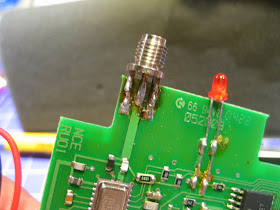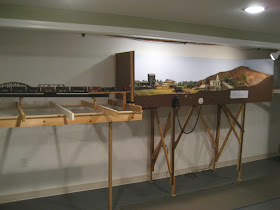The window for the end of steam on the Airline was/is a little tighter. Based on a John Wallace photo from "winter 1949" and knowing that a diesel would be assigned by April 24, 1949 (again, based on the EAB), I concluded that the end of steam had to have been sometime between January/February and April. Considering the (lack of) snow cover in John's photo, my best guess was March, 1949.
What continued to bother me though was my uncertainty about Leroy Beaujon's photo of 3022 in Canaan in the "Winter of 1949." I didn't expect that the 3022 did any "traveling" so I concluded that it had been assigned to Canaan after it left the Air Line. So I figured "Winter of 1949" must've meant "December 1949."
Well, looks like I was mistaken. According to Tom Curtin (NHRHTA board member and one who's as particular as I am about such things), the 3022 did do some traveling - and got to Canaan much earlier than I thought. Here's what he wrote (quoting with permission):
"Here’s an addition to your info. The 3022 did some traveling in 1948. It may or may not have been the last steam on the Air Line local but it surely was the most regularly used one near the end. That’s the clear evidence from both John Wallace’s and Kent Cochrane’s photos. I don’t know when it last ran there but I do believe steam ran later on the Air Line than on the Valley (perhaps only a couple of months later but definitely later).
"Lee Beaujon’s photo of 3022 on the Berkshire was taken about the same time, perhaps even the same day, as the derailment of 3011 on the Valley. The story is there was a bad storm on or about 12/20/48 (That’s the snow visible in the 3011 derailment photo) which caused some bad flooding along the Housatonic [River], and water on the tracks. The Berkshire [Line, which goes through Canaan] had been fully dieselized since early January 1948 (almost all RS-2s but an RS-1 did show up). The RS-2s couldn’t run with “wet feet” so to keep some kind of freight going there the RR sent 3022 over for a couple of weeks. That’s when Lee got his photo. Casey Cavanaugh who lived in Cornwall Bridge and was a high school student at the time has recollections of this event too.
"Now … since it is pretty sure that the Air Line was still in steam in the winter of 1949, what ran the Air Line local when 3022 was over on The Berkshire? Well, I have no idea but it could obviously have been another J OR perhaps a 3300 (R-1 4-8-2). A 3300 showed up on the Air Line too."
Hmmm.... Very interesting for sure. (well, to me anyway). Tom confirms that steam ran later on the Air line than the Valley line. I'll have to see if I can find any photos of other J-class mikados working the Air Line toward the end, but we know from photos that 3300s also ran on the Air Line, and John Wallace's recollection was that this was especially true during "stone season." There was a major trap rock quarry on the Air Line at Reed's Gap (Wallingford/Middlefield) and quarrying took place as long as the ground wasn't frozen and the rock wouldn't freeze in the cars.
One of the most enjoyable aspects of this hobby is the research that's involved in modeling a prototype. There's always some new information to uncover and you can have a lot of fun with all the historical detective work. While this "breaking news" is best put in the form of a blog post, I'll be updating the "Steam on the CT Valley" page on the website as well (see under "Choosing an Era" in the lefthand column). That way, this additional piece of the puzzle can be put in its place and provide an ever-clearer picture of what happened on this line almost 70 years ago.
One of the most enjoyable aspects of this hobby is the research that's involved in modeling a prototype. There's always some new information to uncover and you can have a lot of fun with all the historical detective work. While this "breaking news" is best put in the form of a blog post, I'll be updating the "Steam on the CT Valley" page on the website as well (see under "Choosing an Era" in the lefthand column). That way, this additional piece of the puzzle can be put in its place and provide an ever-clearer picture of what happened on this line almost 70 years ago.

























































